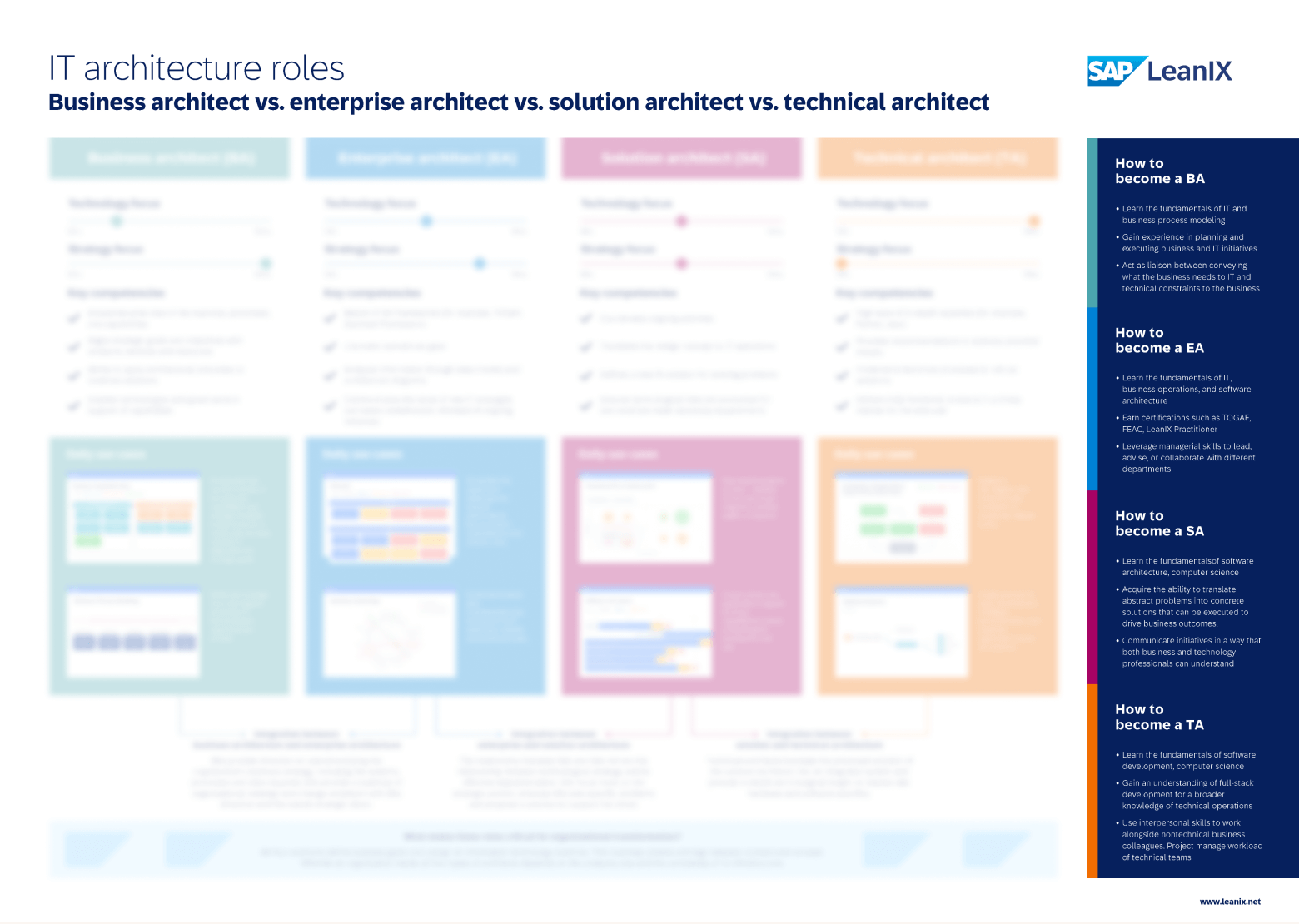Introduction
Over the past decade, digital trends like cloud computing and service-oriented applications have led to new market opportunities across all industries. However, these changes also come with unique challenges and add complexity to the digital landscape of an organization.
And when new solutions aren’t perfectly tailored to an enterprise, they yield unsatisfying results and create unwanted problems. Thus, the successful launch of digital projects requires a set of guidelines that align business interests with new IT solutions.
And this is where solution architecture (SA) comes into play. It is an architectural description of a specific solution based on predefined processes and best practices. As the initial step for creating new enterprise solutions, it ensures that every solution meets the business requirements and fits into the enterprise architecture as a whole.
From a bird-eye view, solution architects can be seen as the link between enterprise architects and technical architects as they’re trying to find the right IT answer to a specific business riddle.
But what does this process actually look like and how can solution architecture best practices help take your business to the next level?
What does solution architecture mean?
Solution architecture provides the ground for software development projects by tailoring IT solutions to specific business needs and defining their functional requirements and stages of implementation. It is comprised of many subprocesses that draw guidance from various enterprise architecture viewpoints.
To better understand the role of solution architecture in the context of software development, you first need to think about what a solution is. Even though this might seem quite basic, it illustrates why solution architecture is one of the most important processes when re-designing your IT landscape. At its core, a solution is a way to describe an answer to a problem. In the corporate world, this means evaluating client needs or problems and addressing them with systems that replace or improve the existing system.
In solution architecture, the client needs are expanded to business needs that in one way or another are related to technology. These needs usually crystallize through re-assessing existing systems and finding out how they benefit or harm the organization in the long run. Sometimes, these evaluations are run by business analysts who also provide a definition of the problem. In the next step, solution architects take this problem and start crafting a description of solutions that appropriately address this need.
Thus, solution architecture translates technical business needs into practical IT solutions while establishing rules and instructions for proper implementation and delivery. It also considers all external factors that could have an impact on the development process. This way, digital projects are less likely to fail and there is a consensus between EA teams and development teams. SA can be seen as a support system that provides structure and reduces the scope of complexity when developing and rolling out new systems and applications.
The difference between solution architecture and enterprise architecture
Even though they’re interdependent and ultimately have the same goal – which is creating more value for a business through the proper use of technology – solution architecture and enterprise architecture focus on different tasks and therefore require different skill sets. As the name already suggests, enterprise architecture paints a big picture of the enterprise that includes all business entities and their relationship to technology and applications. EA is particularly concerned with the lifecycle of applications and defining IT strategies.
These strategies are aimed to reduce costs, eliminate redundant applications, technologies, or processes, and are meant to mitigate and manage the impact of a digital makeover. Not surprisingly, developing a target architecture requires an understanding of the entire organization and close collaboration with leaders and stakeholders. Given the holistic view that enterprise architects need to have of a company, their focus on detail is rather limited. That’s why they’re less concerned with the technical side of the IT infrastructure.
Even though enterprise architects sometimes deal with technical questions, they delegate specific tasks to solution architects who then craft appropriate solutions. However, SA is not directly in charge of the execution process but makes sure that technical architects can successfully implement new IT solutions that are in line with all business requirements. In the overall context, both EA and SA have guiding purposes. While enterprise architecture focuses on strategy, solution architecture focuses on detailed planning.
It’s important to understand that enterprise architects and solution architects are not opposed to each other but form a synergy with technical architects. All three are integral elements when it comes to maximizing the value that a company can generate through the use of technology. Although there might be overlaps between EA and SA, they have different functions and depend on each other as solution architects take the abstract strategy developed by enterprise architects and turn it into a solution.
The role of a solution architect
Since the IT world is changing at a dramatic pace, there has been a lack of consensus when it comes to defining the role of a solution architect. Because just like within the field of enterprise architecture, there’s a level of abstraction that might be hard to grasp from a non-technical perspective. It’s dangerous to assume that hiring an enterprise architect who delegates tasks to development teams can cut out the middleman. The solution architect is absolutely necessary to ensure that solutions are implemented correctly.
But what does the role of a solution architect look like in practice and what kind of skills are needed to successfully manage an IT project to completion?
It’s now clear that a solution architect’s main job is to find the best possible answers to technical problems. The process itself is defined by solution architecture best practices. This means that established industry patterns and standards should be used when creating conceptual models. The detailed solutions are then shared with developing teams, often in the form of a solution architecture diagram or a written document.
However, solution architects don’t just hand out instructions and then leave the scene. They work closely with technical architects and manage all the tasks that are needed for the project to succeed. This involves overseeing time schedules, monitoring technological risks, and ensuring that each activity aligns with the business requirements described in the solution. Therefore, the role of a solution architect can be compared to a technical project manager who keeps track of the project throughout all phases.
Ideally, a solution architect should have technical skills and past architecture experience. And the reason is simple. Solution architects are the link between the business strategy and IT operations and therefore need to have an understanding of an organization’s architectural environment as well as real-life technical solutions. In their role, they need to establish credibility with both business leaders and IT experts. That is why good communication with a non-technical and highly technical audience is key.



/EN/White-Paper/Insight_Communication_Engagement_How_EA_Supports_Change_Management_EN-thumbnail.png?width=260&height=171&name=Insight_Communication_Engagement_How_EA_Supports_Change_Management_EN-thumbnail.png)


